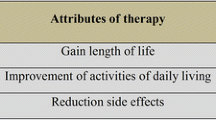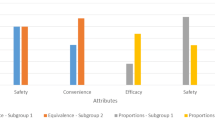Abstract
There is growing recognition of the importance of formally including public preferences and values in societal decision-making processes. Constant-sum paired comparison (CSPC), sometimes known as a ‘budget pie’ task, is a stated preference method than can be used to elicit and measure these preferences and values. It requires respondents to allocate resources between two alternatives, and the relative allocation of this resource is assumed to reflect the importance or priority that respondents attach to the attribute levels in each alternative. CSPC is useful in addressing questions over preferences for the distribution of resources, and allows for an explicit linkage of budget constraints, opportunity costs, outcomes and group characteristics. A key property of CSPC is the ability to allocate some resources to the less preferred alternative, forcing respondents to reflect on the relative value of both alternatives, and possibly giving it an advantage in contexts such as healthcare where respondents may find it ethically difficult or objectionable to make all-or-nothing allocations. This tutorial will outline the theory underlying CSPC, and will work through a detailed example of administering and interpreting a CSPC elicitation, including defining attributes and levels, constructing experimental design, task presentation, and analysis and interpretation.


Similar content being viewed by others
Notes
CSPC asks respondents to allocate a quantity between two alternatives, and is similar to constant-sum scaling (CSS), which asks respondents to allocate a quantity between different attributes within a single alternative. Both CSPC and CSS are sometimes referred to as ‘budget pie’ tasks, but as there are fundamental differences between the two formats, this term will be avoided here.
References
Broqvist M, Garpenby P. To accept, or not to accept, that is the question: citizen reactions to rationing. Health Expect. 2014;17:82–92.
Fleck LM. Just caring: health reform and health care rationing. J Med Philos. 1994;19:435–43.
Mullen PM. Public involvement in health care priority setting: an overview of methods for eliciting values. Health Expect. 1999;2:222–34.
Whitty JA, Lancsar E, Rixon K, Golenko X, Ratcliffe J. A systematic review of stated preference studies reporting public preferences for healthcare priority setting. Patient. Epub 19 May 2014.
Schwappach DL. Does it matter who you are or what you gain? An experimental study of preferences for resource allocation. Health Econ. 2003;12:255–67.
Hensher DA, Greene WH, Rose JM. Applied choice analysis: a primer. Cambridge: Cambridge University Press; 2005.
Carson RT, Louviere JJ. A common nomenclature for stated preference elicitation approaches. Environ Resour Econ. 2011;49:539–59.
Kjær T. A review of the discrete choice experiment—with emphasis on its application in health care. University of Southern Denmark; 2005. Available from: http://static.sdu.dk/mediafiles//Files/Om_SDU/Centre/c_ist_sundoke/Forskningsdokumenter/publications/Workingpapers/20051pdf.pdf.
Louviere JJ, Hensher DA, Swait JD. Conjoint preference elicitation methods in the broader context of random utility theory preference elicitation methods. In: Gustafsson A, Herrmann A, Huber F, editors. Conjoint measurement: methods and applications. Berlin: Springer; 2000. pp. 167–98.
Swallow SK, Opaluch JJ, Weaver TF. Strength-of-preference indicators and an ordered-response model for ordinarily dichotomous, discrete choice data. J Environ Econ Manag. 2001;41:70–93.
Bridges JFP, Hauber AB, Marshall D, Lloyd A, Prosser LA, Regier DA, et al. Conjoint analysis applications in health—a checklist: a report of the ISPOR Good Research Practices for Conjoint Analysis Task Force. Value Health. 2011;14:403–13.
Reed Johnson F, Lancsar E, Marshall D, Kilambi V, Mühlbacher A, Regier DA, et al. Constructing experimental designs for discrete-choice experiments: report of the ISPOR conjoint analysis experimental design good research practices task force. Value Health. 2013;16:3–13.
Skedgel CD, Wailoo AJ, Akehurst RL. Choosing vs. allocating: discrete choice experiments and constant-sum paired comparisons for the elicitation of societal preferences. Health Expectations. Epub 12 Jun 2013. doi:10.1111/hex.12098.
Wagstaff A. QALYs and the equity-efficiency trade-off. J Health Econ. 1991;10:21–41.
R Core Team. R: a language and environment for statistical computing. Vienna; 2013. Available from: http://www.R-project.org/. Accessed 3 Mar 2014
Kuhfeld WF. Marketing research methods in SAS. Marketing research methods in SAS. 2010. Available from: http://support.sas.com/resources/papers/tnote/tnote_marketresearch.html. Accessed 1 Dec 2010
Wheeler B. AlgDesign: algorithmic experimental design. 2014. Available from: http://CRAN.R-project.org/package=AlgDesign.
Aizaki H. Basic functions for supporting an implementation of choice experiments in R. J Stat Softw Code Snippets. 2012;50:1–24.
Ubel PA, Loewenstein G. Public perceptions of the importance of prognosis in allocating transplantable livers to children. Med Decis Making. 1996;16:234–41.
Ratcliffe J. Public preferences for the allocation of donor liver grafts for transplantation. Health Econ. 2000;9:137–48.
Chan HM, Cheung GMY, Yip AKW. Selection criteria for recipients of scarce donor livers: a public opinion survey in Hong Kong. Hong Kong Med J. 2006;12:40–6.
Ryan M, Scott DA, Reeves C, Bate A, van Teijlingen ER, Russell EM, et al. Eliciting public preferences for healthcare: a systematic review of techniques. Health Technol Assess. 2001;5:1–186.
Mathews KE, Freeman ML, Desvousges WH. How and how much? Valuing environmental amenities using stated choice studies. Netherlands: Springer; 2007. pp. 111–33.
Baron J, Greene J. Determinants of insensitivity to quantity in valuation of public goods: contribution, warm glow, budget constraints, availability, and prominence. J Exp Psychol Appl. 1996;2:107–25.
Fischer GW, Carmon Z, Ariely D, Zauberman G. Goal-based construction of preferences: task goals and the prominence effect. Manage Sci. 1999;45:1057–75.
Linley WG, Hughes DA. Societal views on NICE, cancer drugs fund and value-based pricing criteria for prioritising medicines: a cross-sectional survey of 4118 adults in Great Britain. Health Econ. 2013;22(8):948–64.
Carlsson F, Martinsson P. Design techniques for stated preference methods in health economics. Health Econ. 2003;12:281–94.
Desser AS, Gyrd-Hansen D, Olsen JA, Grepperud S, Kristiansen IS. Societal views on orphan drugs: cross sectional survey of Norwegians aged 40 to 67. BMJ. 2010;341:c4715.
Long J. Regression models for categorical and limited dependent variables. Thousand Oaks: Sage Publications; 1997.
Wooldridge JM. Econometric analysis of cross section and panel data. 2nd ed. Cambridge: MIT Press; 2010.
Croissant Y, Millo G. Panel data econometrics in R: the plm package. J Stat Softw. 2008;27:1–43.
Greene WH. Econometric analysis. 7th ed. Boston: Prentice Hall; 2012.
Lancsar E, Louviere J, Flynn T. Several methods to investigate relative attribute impact in stated preference experiments. Soc Sci Med. 2007;64:1738–53.
Lancsar E, Louviere J. Deleting, “irrational” responses from discrete choice experiments: a case of investigating or imposing preferences? Health Econ. 2006;15:797–811.
Scott A. Identifying and analysing dominant preferences in discrete choice experiments: an application in health care. J Econ Psychol. 2002;23:383–98.
Bartels DM, Medin DL. Are morally motivated decision makers insensitive to the consequences of their choices? Psychol Sci. 2007;18:24–8.
Schwappach DL, Strasmann TJ. “Quick and dirty numbers”? The reliability of a stated-preference technique for the measurement of preferences for resource allocation. J Health Econ. 2006;25:432–48.
Green C. On the societal value of health care: what do we know about the person trade-off technique? Health Econ. 2001;10:233–43.
Damschroder LJ, Roberts TR, Zikmund-Fisher BJ, Ubel PA. Why people refuse to make tradeoffs in person tradeoff elicitations: a matter of perspective? Med Decis Making. 2007;27:266–80.
Nord E. The person-trade-off approach to valuing health-care programs. Med Decis Making. 1995;15:201–8.
Rossi PE, Allenby GM, McCulloch R. Bayesian statistics and marketing. 1st ed. Hoboken: Wiley; 2005.
Ryan M, Netten A, Skatun D, Smith P. Using discrete choice experiments to estimate a preference-based measure of outcome: an application to social care for older people. J Health Econ. 2006;25:927–44.
Bridges JFP, Kinter ET, Schmeding A, Rudolph I, Mühlbacher A. Can patients diagnosed with schizophrenia complete choice-based conjoint analysis tasks? Patient Patient Cent Outcome Res. 2011;4:267–75.
Acknowledgments
The authors have no conflicts of interest to declare. Chris Skedgel and Dean Regier contributed to drafting the manuscript. Chris Skedgel conducted the data analysis, and acted as the overall guarantor. The Canadian Centre for Applied Research in Cancer Control receives core funding from the Canadian Cancer Society.
Author information
Authors and Affiliations
Corresponding author
Electronic supplementary material
Below is the link to the electronic supplementary material.
Rights and permissions
About this article
Cite this article
Skedgel, C., Regier, D.A. Constant-Sum Paired Comparisons for Eliciting Stated Preferences: A Tutorial. Patient 8, 155–163 (2015). https://doi.org/10.1007/s40271-014-0077-9
Published:
Issue Date:
DOI: https://doi.org/10.1007/s40271-014-0077-9




